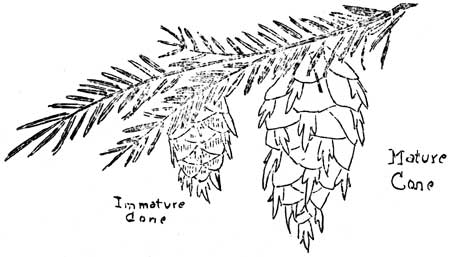TREES OF MOUNT RAINIER NATIONAL PARK
The Douglas Fir----Pseudotsuga taxifolia
If one were asked to name the most outstanding tree in the forests of
Mount Rainier National Park there could be but one answer--the Douglas
Fir. Nor is its fame limited to the 360 miles that are included within
the park boundaries. It is the most important and most magnificient
tree of the Pacific Northwest and commercially the most important
conifer, or "softwood", in the world.
The Douglas Fir is found growing in many sections of the west as far
east as central Nebraska but nowhere in this wide range does it attain
the huge proportions that are customary in the Pacific Northwest. It is
often eight, ten or even twelve feet in diameter, rearing its huge boll
250 feet above the forest floor. In the dense timbers its trunk is
usually free from limbs throughout two thirds of its great height and
encased in an armour of extremely thick bark which serves to protect it
from the ravages of forest fires.
This tree has been known by a number of common names, due chiefly to
the confusion on the part of the early settlers regarding its
identification. It has been known as Oregon Pine, Red Fir, Douglas
Spruce as well as Douglas Fir and the scientific name means "false
hemlock with foliage like a yew". Its correct common name is Douglas
Fir, however, it is not a true fir; with one other relative being a
separate tree group. One may recognize it by the thick, deeply furrowed
bark but the outstanding feature is the cone. This is about 2-1/2 to 3
inches long, hangs down from the branches and between the cone scales
protrude long three pointed bracts that give the cone a decided
"feathered" appearance. Its foliage is, like many of the cone bearing
trees, needle-like in character, flat and soft to the touch. We find it
most abundant where there is an abundance of sunlight for it does not
thrive in the shade. In the dense woods it is always the dominant tree
where it contains the much needed sunlight by overtopping its
association. From the standpoint of reforestation it is the utmost
importance for in addition to being a valuable timber tree it bears an
abundance of seed and with a little help from man will quickly reseed
cut over or burned over areas. The Douglas Fir is KING of the
forest!
By C.F. Brockman, Information Ranger.


